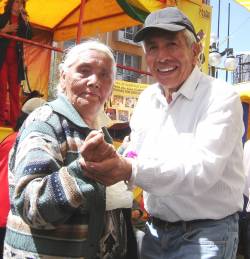This blog explores some of the key findings from Pension watch briefing 12 which is available in English and in Spanish. These are based on two longer pieces of research (in Spanish).

Since 2008, Bolivia’s social protection regime for older people has gained special attention across Latin America due to the implementation of a universal non-contributory pension scheme, Renta Dignidad (Dignity Pension).
The Renta Dignidad was established in response to low coverage rates of the contributory pension: which only covered 14 per cent of older people. It replaces an annual cash transfer which has been given to older people since 1997 and made important improvements in its design. These improvements include: a reduction in the age of eligibility from 65 to 60 years old, a monthly payment instead of an annual one and a bigger amount for those not covered by the contributory system.
By 2012, the Renta Dignidad was being paid to more than 835,422 older people (91% of the population over 60), and had reached a cost of around 1% of Bolivia’s GDP. The program is financed by income resources from oil production which is then transferred to a fund that generates additional income from investments.
The amount of the pension hadn’t changed since the implementation of the program in February 2008; US$ 28.7 (Bs200) for older people with no contributory pension and US$ 21.6 (Bs150) for those with contributory pensions. However, in 2013 the government decided to increase the amount of the pension by a lump sum of US$ 7.2 (Bs50) for all beneficiaries.
What impact has the pension had?
After several years of implementation, there was the need to determine what impact the pension had on the older population. To do this, we conducted a study to determine the main impacts of the program, based on a national survey of households with older people.
The study compared the situation of households who were receiving a pension and were just above the eligibility age (60-65), with a control group of those who were slightly below the eligibility age (55-59). We found that levels of per capita income and consumption were significantly higher in households which were receiving the Renta Dignidad. More importantly, the Renta Dignidad had a significant impact by reducing both official and subjective poverty rates among households.
The study also found additional impacts on other members within the household, especially children. The results show that children living in households receiving the Renta Dignidad were less likely to be working, with rates of child labour less than half that of the control group. Furthermore, school enrolment of children within households receiving the pension is close to universal.
These results show that the Renta Dignidad is an effective component of Bolivia’s social protection system which has positive impacts, not only on the older people who receive it, but also on those who live with them.
Joel Mendizabal (joelmendizabal@gmail.com) is a specialist at the Unit of Social and Economic Policy Analysis (Bolivia), evaluating policies in pensions, banking and insurances. He previously worked at the Ministry of Economics and Finance.
